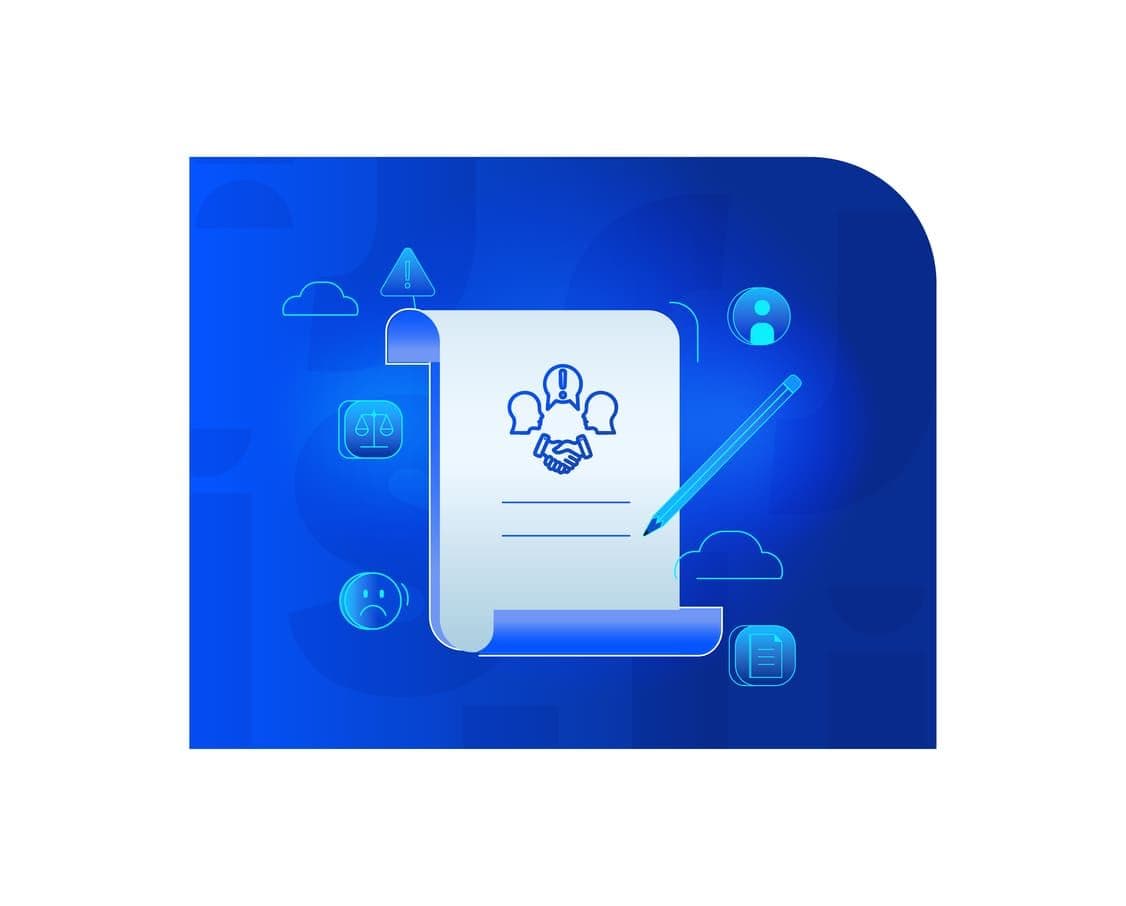Workplace Dispute Resolution & Grievance Handling Policy
Feelings of injustice and dissatisfaction fester like fire under ashes. That's why grievance handling policy aims to establish a secure process for raising grievances and resolving disputes. The grievance handling and dispute resolution policy outlines the process for submitting a grievance, the investigation procedure, and the subsequent solutions and responses.

Created by
Ahmed Abdel Wahab
|
Human Resources Adviser
Share the calculator with an HR college
What’s included in the grievance handling and dispute resolution policy?
The grievance handling and dispute resolution Policy clarifies how employees can voice their concerns. It declares the company's commitment to understanding the issues that trouble employees and hinder their work, aiming to resolve disputes fairly and swiftly. This includes concerns related to the workplace, their jobs, or relationships with colleagues.
The grievance handling policy explains the process for raising and reviewing grievances, including the different stages and timeframe, both formal and informal, depending on the severity and nature of the issue. It also specifies the involved parties, the timing for each stage, and settlement methods like mediation sessions and arbitration .
Recognizing that appeals are a guaranteed right by law, the policy details the appeal process. It covers how appeals are handled by gathering more information and conducting a more extensive investigation, while also designating the authority responsible for reviewing the appeal and reaching a binding decision within a specific timeframe.
Grievance Policy Template - Table of contents
1. Introduction & Scope
2. Grievance Submission & Registration
3. Investigation Process
4. Resolution & Response
5. Appeal Process & Final Decision
6. Dispute Resolution & Mediation
7. Arbitration & Binding Decisions
8. Confidentiality & Protection
9. Documentation & Record Keeping Drag
Why do you need a grievance handling and dispute resolution policy?
Sending respect and attentiveness messages to employees, showing concerns are valued.
Preventing disputes from escalating to serious stages that harm productivity.
Ensuring fairness and transparency in handling all complaints and disputes.
Fostering a supportive and comfortable work environment for everyone.
How do you use the model?
Download the template and review the content.
Customize it with name, logo and your own specific procedures and timeline.
Add it to employee handbook and have employees sign that they have read it.
Ensure compliance by getting grievance handling policy reviewed by a legal/HR expert.
See Jisr in action
Scale HR operations, manage talent, control spend – all in one platform with Jisr. Get started in weeks, not months.

FAQ
Dispute Resolution Policy outlines a process for addressing and resolving disagreements or conflicts among employees, or between employees and management, aiming for a fair and timely resolution.
It details the steps individuals can take when encountering a workplace dispute, often prioritizing informal methods like direct discussion or mediation before resorting to more formal internal processes.
Key aspects include defining stages of resolution, assigning roles and responsibilities (e.g., HR or managers), setting internal timelines, ensuring confidentiality, and maintaining records for transparency.
To effectively handle workplace dispute, proceed with the following dispute resolution process:
Encourage open communication: Foster an environment where employees feel comfortable expressing concerns.
Listen to both sides: Meet with all involved parties and actively listen to their perspectives without interruption.
Remain objective and fair: Focus on facts and evidence, treating everyone respectfully.
Identify the root cause: Work to understand the underlying issues of the dispute.
Brainstorm solutions: Collaborate with employees to find mutually agreeable outcomes.
Develop a plan of action: Create a clear plan with steps and timelines once a solution is agreed upon.
To write an effective Grievance Handling and Dispute Resolution policy:
Identify key points of contact: Designate specific individuals or a committee with the appropriate leadership role or experience to handle employee concerns. Ensure all employees know how to contact them.
Outline preliminary steps for employees: Define in the grievance policy the steps employees should take before formally filing a grievance. This might include directly addressing involved parties or contacting their supervisor first.
Determine grievance handling protocol: Establish how grievances will be investigated. All filed grievances require investigation, regardless of perceived validity. Keep the filing employees informed of the investigation's status and outcome, addressing concerns fairly and promptly to maintain trust.
The 5-step grievance process typically involves:
Informal Discussion: The employee first attempts to resolve the issue informally with their employer.
Formal Grievance Letter: If informal resolution fails, the employee formally raises the issue by submitting a grievance letter.
Grievance Investigation: A thorough investigation into the grievance should then be conducted by the employer.
Grievance Hearing: A formal hearing may be held to review all evidence and for a decision to be made regarding the grievance.
Right to Appeal: The employee retains the right to appeal the outcome of the grievance if they are not satisfied with the decision.
A sample dispute resolution clause might look like this: "Any workplace dispute related to this policy will first be addressed through internal mediation. If mediation doesn't resolve the issue within [number] days, the matter can be escalated to [e.g., HR review, a formal grievance hearing] following the company's established procedures, with a final decision made within [number] days.